Understanding Ghana's Coastal Erosion: Causes, Effects, and Solutions
Understanding Ghana's Coastal Erosion
Ghana, with its stunning coastline stretching over 500 kilometers along the Gulf of Guinea, boasts beautiful beaches, vibrant communities, and rich biodiversity. However, the nation faces a significant environmental challenge: coastal erosion. This natural process is threatening both livelihoods and ecosystems, making it crucial to understand its causes, effects, and potential solutions.

Causes of Coastal Erosion
Coastal erosion in Ghana is primarily driven by a combination of natural and human-induced factors. Naturally, the relentless action of waves and tides gradually wears away the land. This process is exacerbated by sea-level rise, a consequence of climate change, which increases the frequency and intensity of tidal surges.
Human activities also play a major role in accelerating coastal erosion. Sand mining for construction purposes, for instance, removes vital materials that help to protect the shoreline. Additionally, poorly planned coastal developments disrupt natural sediment flow and contribute to further erosion.

Effects on Communities and Ecosystems
The effects of coastal erosion in Ghana are profound. For coastal communities, the loss of land translates into the loss of homes, agricultural fields, and fishing sites. This not only affects their economic stability but also displaces families and disrupts social structures.
Ecologically, erosion threatens vital coastal habitats like mangroves and wetlands. These areas are crucial for biodiversity as they provide breeding grounds for numerous species and act as natural buffers against storms. The degradation of these habitats can lead to a decline in fish populations, impacting both local economies and food security.

Proposed Solutions
Addressing coastal erosion requires a multi-faceted approach. One effective strategy is the implementation of coastal defense structures, such as seawalls and groynes, which can help to stabilize the shoreline. However, these structures must be carefully designed to avoid adverse effects on neighboring areas.
Another important solution is the restoration of natural barriers like mangroves and dunes. These ecosystems not only reduce erosion but also enhance biodiversity and carbon sequestration. Community involvement is key in these projects, as local knowledge and participation ensure sustainable outcomes.

Policy and Community Engagement
Effective policy frameworks are essential for combating coastal erosion in Ghana. The government must prioritize regulations that limit harmful activities such as illegal sand mining and unregulated coastal development. Additionally, policies should support sustainable land-use planning that balances development with environmental preservation.
Community engagement is equally vital. Educating local populations about the causes and impacts of coastal erosion can foster a sense of ownership and responsibility towards coastal management efforts. Engaging communities in conservation projects not only empowers them but also ensures that solutions are locally adapted and culturally appropriate.
In conclusion, understanding and addressing Ghana's coastal erosion requires a collaborative effort between government agencies, communities, and environmental organizations. By combining scientific research with traditional knowledge and innovative solutions, Ghana can protect its coastlines for future generations.